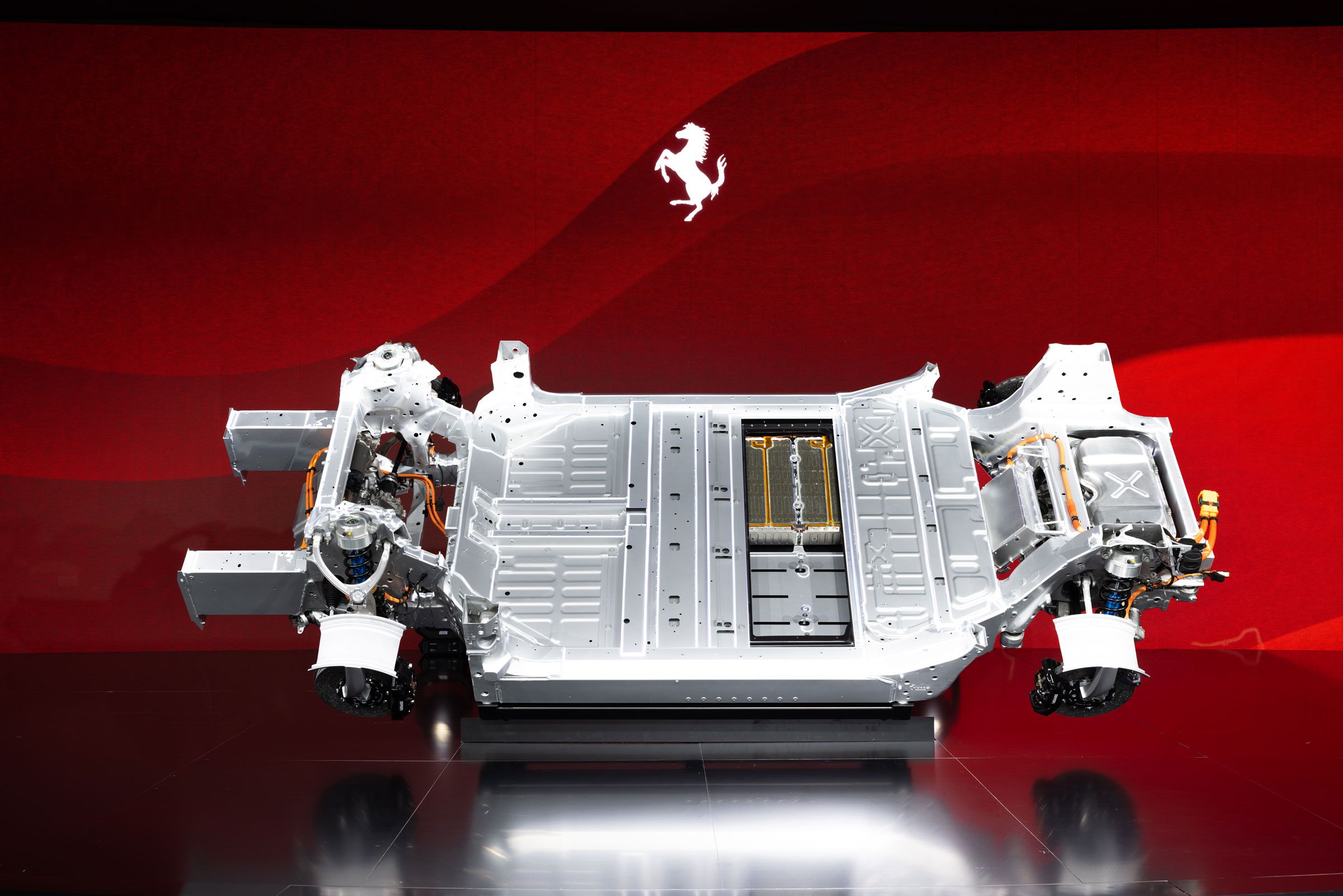Enzo Ferrari said he was a seller of engines and that the rest of the car is thrown in for free, such was the emphasis he and his company put on its jewel-like power units. Can the same ever be true of an electric car’s seemingly soulless motors, batteries, and inverters? That is the question Ferrari is at pains to answer in the positive with its first EV.
Although nameless for now, the four-door car will use a new electric platform called Elettrica. The platform is a familiar skateboard EV chassis setup, as used by almost everyone else, but with four motors instead of the more common one or two.
Total power is a little over 1,000 horsepower, the 0-62 mph time is 2.5 seconds and the top speed is 192 mph. The battery has a gross capacity of 122 kWh—one of the largest fitted to any production EV to date—can charge at up to 350 kW and operates at 880 volts. Ferrari is claiming a range of over 323 miles, suggesting an efficiency of around 2.65 miles per kWh, excluding any mileage gained through regenerative braking. Weight is approximately 2,300 kg (5,070 lbs).

Ferrari’s 122 kWh battery is one of the largest fitted to any production EV and can charge at up to 350 kW with a claimed range of over 323 miles.
Courtesy of Ferrari
This was all broadly to be expected. What isn’t known is exactly what sort of car it will be, or what it will be called. Today’s reveal is focused on the Elettrica platform. The interior, which includes the work of a certain Sir Jony Ive, will be shown early next year, and the full car, also penned with input from Ive’s LoveFrom design house, will land in the second quarter of 2026.
For now, chief executive Benedetto Vigna says the staggered reveal is because the first electric Ferrari is “a bigger deal” than its current flagship, the F80 hybrid hypercar.
You can’t blame Ferrari for taking its time. By sticking to big V12 engines and clever hybrids that maximize performance over outright efficiency, the company has become accustomed to operating in a different league to other carmakers. Investors seem unfazed by the lack of an ultra-powerful EV to rival Porsche, Rimac or Lotus—and so Ferrari’s share price is up 900 percent since going public a decade ago.
Its customers are equally happy, frequently shelling out six-figure sums on optional upgrades alone, while understanding that limited-run specials like the F80 are sold by invitation-only, regardless of bank balance.
Rival Delays
Although looming regulation change means Ferrari cannot stick to the same winning formula forever, its first attempt at an EV arrives precisely as once-bullish rivals are reconsidering their position.
Lamborghini has delayed its first EV from 2027 to 2029. Bentley has pushed back its goal of exclusively selling fully electric cars from 2030 to 2035. And only recently Porsche killed plans for an electric flagship SUV, and said how some top-end models would continue to favor engines over batteries. Ferrari’s Modena neighbor Maserati also recently cancelled plans for an electric version of its MC20 supercar, citing a lack of customer interest.
Even the company itself was unsure, albeit now almost a decade ago, when late boss Sergio Marchionne said a battery-powered Ferrari was “almost an obscene concept.” Then again, he was similarly robust about the idea of a Ferrari SUV, only for the high-riding Purosangue to be greeted with critical acclaim and bulging order books from day one.
Ferrari-Made Motors
Back to today and, while it doesn’t want to say what the EV will look like, Ferrari is predictably keen to talk about performance. The front motors produce a combined 210 kW (280 horsepower) and 140 Nm of torque, while the rear pair send 620 kW (830 hp) and 355 Nm to their respective axle. The front and rear motors spin at up to 30,000 and 25,500 revolutions per minute, respectively, and can gain speed at a rate of 45,000 rpm per second.
Ferrari says the motors and battery were developed and built entirely in-house, using the company’s new “e-building” at its Maranello, Italy campus, although the cells come from SK, a South Korean battery manufacturer. The battery pack comprises 211 pouch cells arranged in 15 modules which are designed to be accessed, removed, and replaced if future maintenance requires it.

Ferrari’s setup, including this inverter, sees the carmaker opt for four electric motors instead of just one or two, which results in prodigious power: more than 1,000 hp, 0-62 in 2.5 secs and a top speed of 192 mph.
Courtesy of Ferrari
The first all-electric Ferrari is a four-door, four-seater with the driver and front passenger pushed forward in a bid to create a seating position like that of a mid-engined sports car, while the rear seats are more reclined.
Although the cabin hasn’t been revealed, the EV’s steering will have a pair of dials for switching between three energy modes (Range, Tour and Performance) and five drive modes: Ice, Wet, Dry, Sport, and ESC-Off. The latter will disable most of the Elettrica’s traction and stability systems.
Behind the wheel are a pair of paddles, but instead of operating a transmission, the left-hand paddle cycles through different strengths of regenerative braking, and the right lets the driver access five levels of power and torque, using a new system called Torque Shift Engagement.
Simulated Shifting, “Real” Sound
Although not quite the simulated gearbox of the Hyundai Ioniq 5 N, Ferrari says the regenerative braking modes give a sensation similar to engine braking when shifting down through the gears of a non-EV. Meanwhile, the five power and torque levels “deliver progressively stronger acceleration” with subsequent pulls of the right-hand paddle.
With regard to sound, Ferrari says it quickly dismissed the two approaches taken by most other EVs; namely, copying the sound of an engine, and producing something entirely synthesized. Instead, the Elettrica uses an accelerometer fitted to the rear axle. Like the pickup of an electric guitar, this senses vibrations produced by the motors, which are then processed and filtered—to remove annoying traits like constant whine, Ferrari says—and fed into the cabin.
Ferrari likens the sound of an engine and exhaust to that of an acoustic guitar, while it says the Elettrica’s is closer to an amplified electric guitar. “The sound is authentic,” says Antonio Palermo, sound quality manager. “It belongs to the components of the powertrain.”
Palermo says the sound can be reduced when cruising, then amplified during more dynamic driving. Allegedly, it’s even possible to sense when a rear wheel breaks traction, since the rise in revs of that motor would be detected by the accelerometer. He also says how latency—the time between a change in motor revs and the sound reaching the driver’s ear—is “below the threshold of human perception… instantaneous.”
The sound will also adjust depending on how the driver engages with the steering wheel paddles for regenerative braking and the Torque Shift Engagement system. But, for now, Ferrari refuses to comment on exactly how motor sound is broadcast in the cabin—be it through the car’s sound system, or some other means—and how external sound will be created. Underscoring Ferrari’s commitment to using an authentic drivetrain sound, Palermo adds: “It’s an instrument, not a ringtone.”
Individually Controlled Wheels
Remarkably, for a company whose cars are synonymous with theatrical histrionics, Ferrari says during normal driving “silence is preferred to maximize acoustic comfort.” To that end, it has worked hard to illuminate noise, vibration, and harshness (known in the industry as NVH), since there’s no longer a loud engine to drown it all out.
The Elettrica’s suspension is an evolution of the active system used by Ferrari’s Purosangue SUV and F80 hypercar, which employs 48-volt motors to apply torque to each shock absorber, actively working to eliminate pitch and roll.
As with other electric cars, a heavy battery pack in the floor helps to lower the center of gravity; in this case, by 80 mm compared to an equivalent non-EV. Although it can’t defy physics, Ferrari claims its suspension trickery and quad-motor setup makes the Elettrica handle as if it were almost 1,000 lbs lighter.
The result is a car where each wheel has its own individually controlled power, braking, suspension, and steering—with the rear wheels even able to be steered independently of each other, by up to 2.15 degrees in either direction. Each of the four motors can also operate their own regenerative braking, with up to 0.68G of deceleration possible with the most aggressive level of regen. That’s more than half the braking force experienced during an emergency stop in a regular car.

Each of the electric Ferrrari’s four wheels has its own individually controlled power, braking, suspension, and steering—with the rear wheels even able to be steered independently of each other.
Courtesy of Ferrari
Seriously Confident
Ferrari has said repeatedly that its first EV is not a supercar. It suggests this car will offer more usability than the V12 Purosangue SUV, with driving thrills to match the new Almalfi, a front-engined replacement to the Roma, but not trouble the more potent 12Cilindri and 296.
It’s a confident first reveal from Ferrari, and one that manages to suggest there’s more to its debut EV than yet another skateboard chassis. Its use of four motors, trick active suspension, a clever way of producing sound, and, yes, Apple’s former design chief gives the Elettrica serious intrigue at a time when rivals are floundering.
And yet. Despite its technical know-how and massive brand power, convincing buyers to part with what’s likely to be the far side of $500,000 for an EV that is not a supercar will be no walk in the park. Not even for Ferrari.



